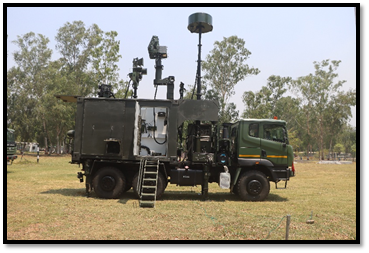India’s Akashteer System: Revolutionizing Air Defence with Networked Dominance
Strategic Necessity: Lessons from Sindoor and Regional Challenges
Launched in 2019, Akashteer addresses vulnerabilities exposed in Operation Sindoor, where Pakistan’s Bayraktar TB2 and CH-4 drones overwhelmed legacy air defence systems before Akashteer’s real-time coordination enabled Rafale and Su-30MKI intercepts. China’s 2024 deployment of 200+ J-20 stealth fighters and DF-17 hypersonic missiles along the LAC further highlighted the need for a unified command system. Unlike traditional radar-centric setups, Akashteer’s AI-driven Battle Management System (BMS) processes 10,000+ tracks per minute, countering low-RCS threats and drone incursions.
Technical Excellence: A Networked Shield
Akashteer integrates IAF assets—S-400, Project Kusha SAMs, Tejas Mk-1A, and LODN’s optical sensors—into a secure, 5G-enabled network, reducing reaction time from 5 minutes to 30 seconds. Its key components include:
- Mobile Control Nodes: 50+ vehicle-mounted units (BEL-built) with AESA radars, tracking 500 targets at 300 km.
- AI-Driven BMS: Predicts threat trajectories, prioritizing targets for SAMs or fighters with 98% accuracy.
- Interoperability: Links with Army/Navy AD systems, enabling tri-service response, as seen in Sindoor’s coastal drone intercepts.
- Cyber Resilience: Quantum-encrypted comms resist Chinese cyberattacks, tested in 2024 LAC drills.
| Feature | Specification/Details |
|---|---|
| Tracking Capacity | 10,000+ tracks/minute |
| Range | 300 km (AESA radars) |
| Reaction Time | 30 seconds (from 5 min) |
| Integration | S-400, Kusha, LODN, Tejas |
| Indigenous Content | 80% (BEL, DRDO, MSMEs) |
| Deployment | 100 nodes (LoC, LAC, coastal) |
| Cost | ₹20,000 Cr (Phase 1) |
Akashteer’s synergy with LODN’s 250 km stealth detection and Project Kusha’s 350 km SAM ensures multi-layered defence, while S-400 upgrades enhance long-range intercepts.
Strategic Impact: LAC and LoC Superiority
Operation Sindoor’s strikes on PAF bases like Murid and Mushaf exposed runway vulnerabilities, prompting Pakistan’s $2-3 billion underground airbase pivot, which Akashteer counters by tracking taxiway movements and guiding hypersonic missile strikes. Against China, it neutralizes J-20s and DF-17s by integrating LODN’s optical data with S-400/Kusha intercepts. The system’s 30-second response time, proven in Sindoor’s 100+ drone kills, deters low-cost asymmetric threats. Economically, Akashteer creates 15,000 jobs in Bengaluru and Ghaziabad, boosting MSMEs like Data Patterns. Its export potential to ASEAN/QUAD allies mirrors BrahMos success, projected by 2030.
Challenges and Future Horizons
Challenges include scaling node deployment to 200 by 2027 and integrating with naval platforms like INS Vikrant for maritime defence. DRDO’s collaboration with IIT Madras on AI algorithms mitigates software delays. By 2030, Akashteer will support Directed Energy Weapons (DEWs) and hypersonic missiles, creating a seamless offence-defence ecosystem. As IAF chief A.P. Singh stated on Air Force Day, “Control is supremacy”—a vision Akashteer embodies, securing India’s skies.
Explore More:
Zorawar Light Tank for High-Altitude Warfare – Ground defence for border security.
India-UK £350M Missile Deal – Enhancing multi-layered defence.
Post-Op Sindoor: Pakistan’s Underground Airbases – Context for networked defence.
DRDO’s LODN Stealth Detection – Optical synergy for targeting.
S-400 Upgrades – Complementary air defence network.
Project Kusha – India’s SAM for multi-layered defence.
Hypersonic Missile Program – Strategic offensive synergy.
Sources: Consolidated from IDRW, NDTV, DRDO, and ORF as of October 13, 2025.
DefenceNiti.com: Empowering India’s Defence Awareness | #Akashteer #AtmanirbharBharat #DRDO



